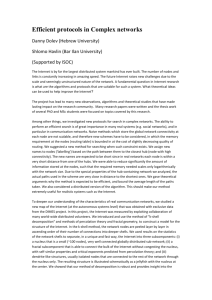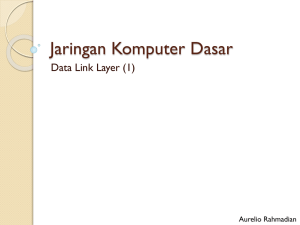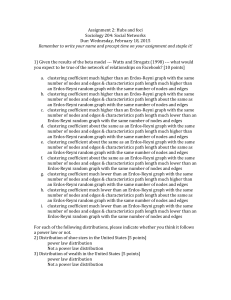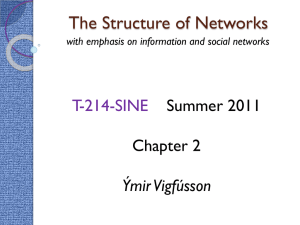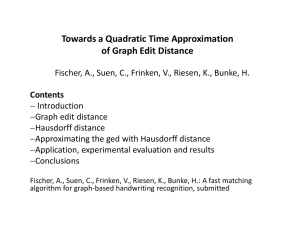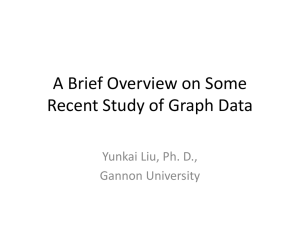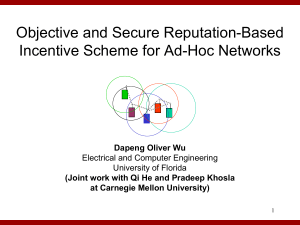Statistical Properties of Community Structure in Large Social and
advertisement
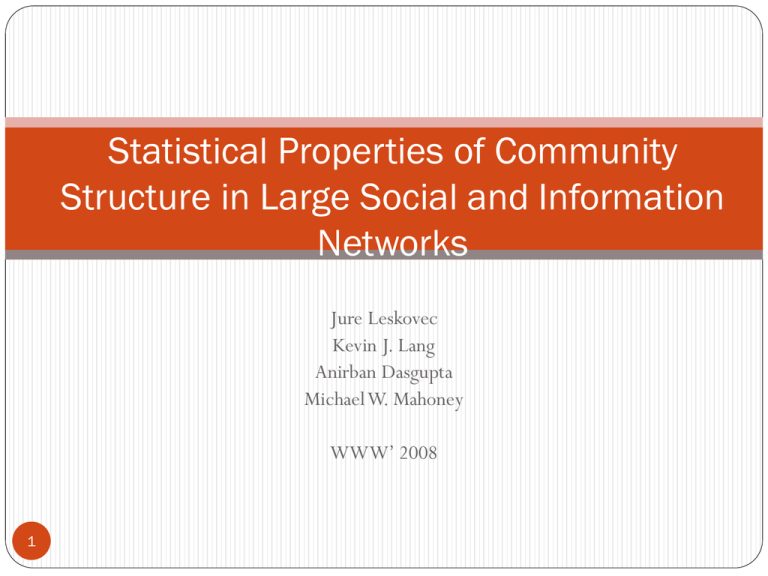
Statistical Properties of Community Structure in Large Social and Information Networks Jure Leskovec Kevin J. Lang Anirban Dasgupta Michael W. Mahoney WWW’ 2008 1 Outline Introduction Background and Overview Network Community Profile Plot More Structural Observations Models for Network Community Structure Conclusion 2 Introduction A community is often though of as a set of nodes that has more connections between its members than to the remainder of the network. The best possible communities gradually “blend in”with the rest of the network and thus become less “community-like.” An iterative “forest fire” burning process 3 Overwiew of our approach 1. Data are modeled by an “interaction graph.” 2. The hypothesis is made that the world contains groups of entities that interact more strongly amongst themselves than with the outside world, and hence the interaction graph should contain sets of nodes. 3. A objective function or metric is chosen to formalize this idea of groups with more intra-group than intergroup connectivity. 4. An algorithm is then selected to find sets of nodes that exactly or approximately optimize this or some other related metric. 5. The clusters (communities) are the evaluated in some way. 4 (cont.) How well do real graphs split into communities? What are typical community sizes and typical community qualities? 5 (cont.) Network community profile (NCP) plot NCP measures the quality of “best” community as a function of community size in a network Conductance measure the quality of a community By this measure, the best communities are densely linked sets of nodes attached to the rest of the network via few edges 6 Summary of our results Main Empirical Findings Up to a size scale, which empirically is roughly 100 nodes At size scale of 100 nodes, we often observe the global minimum of the network community profile plot Above the size scale of roughly 100 nodes “Jellyfish” or “Octopus” structure 7 8 Background and Overview Social nets Information ( citation ) networks Web graphs Bipartite affiliation ( authors-to-papers) networks Internet networks 9 10 Conductance G = ( V , E ) denote a graph. Conductance ∅ of a set of nodes S ⊂V (where S is assumed 11 to contain no more than half of all the nodes.) v is the sum of degrees of nodes in S. s is the number of edges with one endpoint in S and one endpoint is 𝑆 , 𝑆is complement of S. e is the number of edges with both endpoints in S Then ,the conductance of S is ∅= s/v, or ∅= s/( s+2e ). More formally, if A is the adjacency matrix, then v = 4,(node 0,1) s = 2,(node 0) e = 1.(01) ∅(S) = s/v = s/(s+2e) = 1/2 12 Network Community Profile Plot Intuitively, the NCP plot measures the quality of the best possible community in a large network, as a function of the size of the purported community. Metis+MQI Taken together returns sets that have very good conductance values Local Spectral Algorithm Returns sets that are somewhat “regularized” (more internally “coherent”) but that often have worse conductance values. 13 Have examined NCP plots for over 70 real-world social and information networks. The most striking feature is that the NCP plot is steadily increasing for nearly its entire range. 14 15 More Structural Observations There is a substantial fraction of nodes that are barely connected to the main part of the network. In particular, a large fraction of the network is made out of nodes that are not in the (2-edge-connected) core For example, the core of Epinions network contains only 47% of the nodes and 80% of the edges. 16 (cont.) 17 Models for Network Community Structure Address modeling issues in order to understand the properties of generative models sufficient to reproduce the phenomena we have observed 18 Commonly-used network models(cont.) We have studied a wide range of commonly-used network generative models in an effort to reproduce the upward sloping NCP plots and to understand the structural properties of the real-world networks that are responsible for this phenomenon. 19 20 A more realistic model of network community structure(cont.) The question arises as to whether we can find a simple generative model that can explain both the existence of small well-separated whisker-like clusters and also an expander like core whose best clusters get gradually worse as the purported communities increase in size. whisker-like communities(this should reproduce the downward part) expander-like core(This should reproduce the gradual upward sloping part) 21 Forest Fire Model(cont.) The so-called Forest Fire Model captures exactly these two competing phenomena. The Forest Fire Model is a model of graph generation in which new edges are added via a recursive “burning”mechanism in an epidemic-like fashion. 22 23 Conclusion We investigated statistical properties of sets of nodes in large real-world social and information networks that could plausibly be interpreted as good communities, and we discovered that community structure in these networks is very different than what we expected from the literature and from what commonly-used models would suggest. 24

